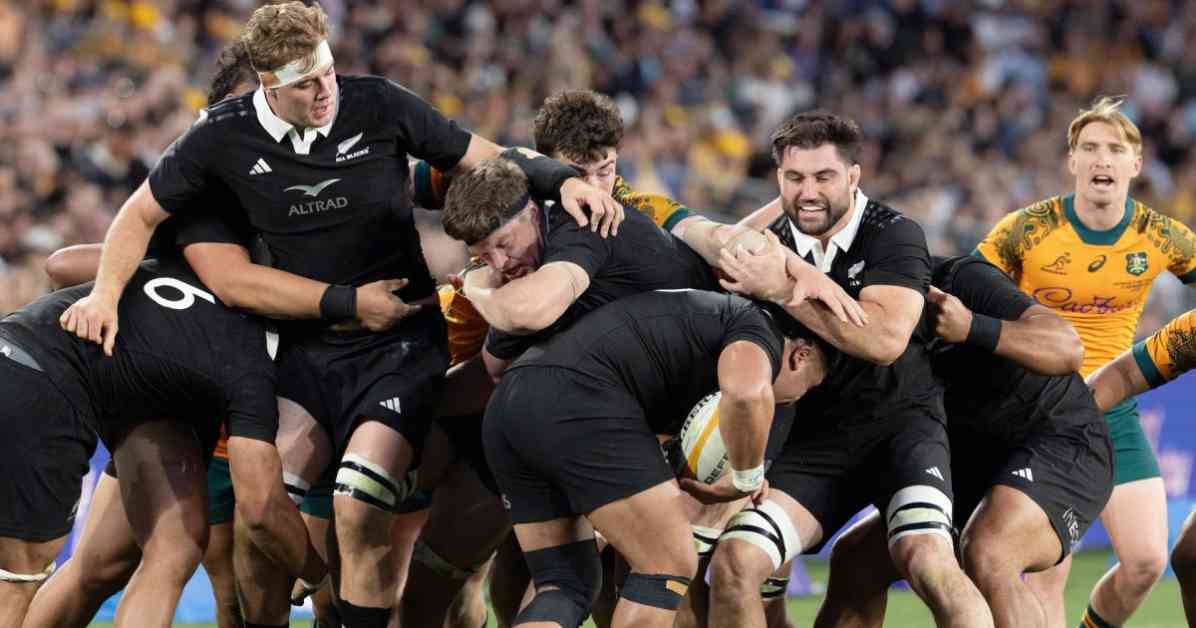The Australasian rugby scene faced a stark reality on Saturday as the All Blacks took on the Wallabies in what turned out to be a disappointing display for both sides. While there were moments of individual brilliance and excitement, the overall match left much to be desired for fans on both sides of the Tasman.
Australia’s performance at the start of the match was lackluster, marked by passivity, errors, and an evident intimidation by the dominant All Blacks. The Wallabies struggled to keep up as the All Blacks quickly raced to a 21-0 lead, showcasing a clear gap in skill and execution between the two teams. The disparity in performance was evident as the match unfolded, leaving many questioning the standard of Bledisloe Cup rugby being displayed.
However, to Australia’s credit, they managed to rally and put up a fight against the All Blacks as the match progressed. Despite their efforts, it was clear that the All Blacks were not operating at their usual high standards, allowing Australia to close the gap and challenge their dominance on the field. The inconsistency in the All Blacks’ performance raised concerns about their ability to meet the expectations of their loyal fanbase and uphold the legacy of the jersey they wear.
While the traditional pre-match rituals like the haka were executed flawlessly, the focus seemed to shift towards appearances rather than on-field performance. Questions arose about the lack of progress in the All Blacks’ strategic development, decision-making, and execution during crucial moments in the game. The repeated mistakes and shortcomings from key players became a cause for concern, leading to doubts about the team’s direction and future prospects.
Despite their 31-28 victory over Australia, the All Blacks’ performance was widely regarded as their worst of the season, casting a shadow over the reputation of New Zealand rugby. The match highlighted the need for a reevaluation of the team’s approach and a more cohesive strategy moving forward.
Comparing Strategic Development: All Blacks vs. South Africa
In contrast to the All Blacks’ struggles, South Africa’s strategic development under the guidance of coach Rassie Erasmus has been met with success and progress. Despite a recent defeat to Argentina, the Springboks have shown a clear plan for the future, balancing current success with long-term goals.
The Springboks’ ability to transition key players from their 2019 Rugby World Cup-winning squad to a new generation of talent reflects a well-thought-out succession plan. This forward-thinking approach not only secures their competitiveness in the present but also ensures a solid foundation for future campaigns, including the upcoming World Cup defense in three years’ time.
On the other hand, the All Blacks’ reliance on established players and lack of significant changes in their lineup raise questions about their strategic vision and development. The absence of new combinations and a clear pathway for emerging talent point to a stagnation in their approach, hindering their ability to evolve and adapt to changing dynamics in the sport.
The Need for Change: Addressing the All Blacks’ Challenges
As the All Blacks continue to face scrutiny for their inconsistent performances and lack of progress, there is a growing call for change within the team. The persistent issues plaguing their game, including a lack of cohesion, poor decision-making, and a failure to capitalize on opportunities, highlight the urgency for a strategic overhaul.
Fans and critics alike have expressed frustration over the repetitive nature of the All Blacks’ shortcomings and the reluctance to address underlying issues. The focus on superficial aspects like appearances and rituals has overshadowed the need for substantive improvements in the team’s playing style and approach to the game.
It is evident that the All Blacks’ current trajectory is unsustainable, and a shift towards a more structured and strategic development plan is imperative. Emulating the success of teams like South Africa, who have embraced change and innovation in their approach, could provide a roadmap for the All Blacks to revitalize their game and reclaim their status as a dominant force in international rugby.
In conclusion, the All Blacks’ strategic development compared to South Africa highlights the importance of long-term planning, succession, and adaptability in achieving sustained success in rugby. Addressing the challenges facing the All Blacks requires a comprehensive reevaluation of their approach, including a focus on talent development, strategic vision, and a commitment to excellence on and off the field. Only through embracing change and innovation can the All Blacks regain their competitive edge and secure their legacy in the world of rugby.
